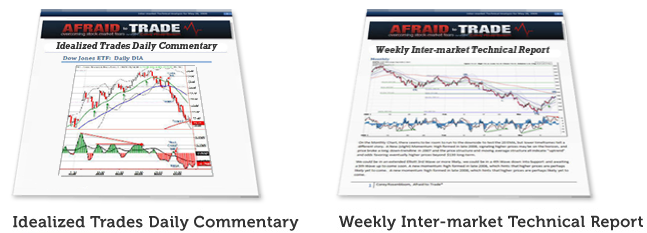Revisiting How to Trade a Simple Bull Flag
One of my favorite intraday patterns is the bull and bear flags.
How do you identify and then trade these patterns?
Let’s focus just on the bull flag for this post.
Why do I like this pattern?
It is relatively simple to identify, only uses price (no complex indicators), and the stop-loss along with profit target projections are clear.
What does it look like?
Graphically, the pattern is comprised of a large volatility upward impulse move (which resembles a ‘flag pole’) which is then followed by a retracement that occurs downward in a near 45 degree angle.
After this retracement is complete, a ‘measured move’ component breaks back to the upside which is roughly equal to the original flag pole portion.
I drew this basic graphic to illustrate the pattern:

The first component is the ‘pole,’ which you often can’t detect as it forms. It is the second component that creates the ‘trade.’
Once you see a clean retracement against a large, near vertical price move, this is your clue to begin looking for this trade.
If the retracement is bound by near parallel channels which form a 45 degree angle, then this increases your confidence that a flag pattern is occurring.
If the retracement pulls back to the 20 period (or some other) moving average, or some other area of perceived support, this adds confidence to this pattern.
Entry
Generally, once you see price retrace about 50% of the initial ‘pole’ or price comes into a support zone, this would be your entry.
If you are an aggressive trader, you can enter as price continues downward in the retracement in anticipation of a reversal.
Generally, you’ll fall victim to less slippage and will get a better position if the measured move occurs.
If you are more conservative, you can actually wait for the price to break out of the upper channel and enter at that point.
You’ll sacrifice initial trade location, but will put the odds a little more in your favor.
Stop and Target
Where do you place your stop and where do I play for a target? It depends on your style of trading.
The stop should go a ‘comfortable’ distance beneath the lower trend channel of the flag portion.
Again, if you are conservative, you can place it just beneath the support zone or bottom trend channel.
If you’re more aggressive, you can place the stop lower than this zone, or even beneath the initial pole (of the impulse).
Keep in mind that you have a clear target once you establish your trade, and so you can easily cut that target in half to establish a clean 2 to 1 reward to risk ratio.
The target is an equal distance of the pole which is added to the bottom of the lower trend channel in the flag.
Example: If the ‘pole’ impulse is $5.00 (taking price from $40 to $45), and the retracement takes price down $2.50 to $42.50, then the ‘measured move’ target would be $42.50 + $5.00 or $47.50.
Your stop could be placed where you are comfortable beneath $42.00.
Where does it occur?
This pattern occurs on any of the intraday time frames and the daily timeframe of ETFs, indexes, and futures contracts.
Classic technical analysis books say that a ‘flag’ portion of the daily chart must unfold in 4 weeks time.
Where can I find examples?
I’m sure I will be discussing this pattern in more detail in the future, as it is one of my favorites. To find all the times I’ve discussed a bull (or bear) flag pattern, feel free to type in the term “bull flag” or “bear flag” in my search box at the top of the blog homepage.

Also, I have selected a few posts to get you started, which show examples on the daily chart and intraday charts:
Ideal Bull Flag on 60-min Chart (DIA)
Summarizing the Day’s Trades (Mar 31, ’08)
POT What?
Consumer Discretionary Sector Analysis (bear flag example)
Bull and Bear Flag Examples
Goldman Sachs Intraday Bear Flag (good example)
Bear Flag forms on Indexes (my projection came true!)
Keep checking back for more information on this pattern.
(this post originally appeared April 4, 2008)
Follow along with members of the Daily Commentary and Idealized Trades summaries for real-time updates and additional trade planning.
Corey Rosenbloom, CMT
Afraid to Trade.com
Follow Corey on Twitter: http://twitter.com/afraidtotrade
Corey’s book The Complete Trading Course (Wiley Finance) is now available along with the newly released Profiting from the Life Cycle of a Stock Trend presentation (also from Wiley).

